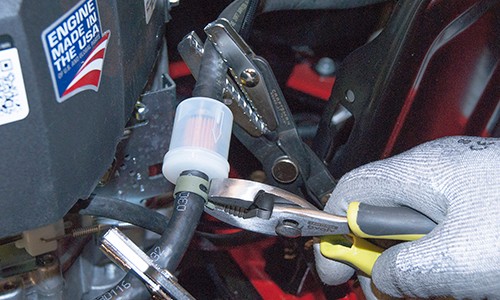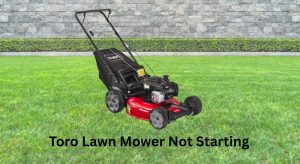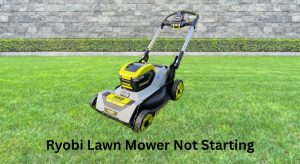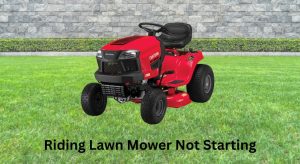Is your riding lawn mower sputtering, stalling, or refusing to start because the fuel filter isn’t filling up? You’re not alone. A fuel filter that stays empty usually points to a supply issue on the tank side or a suction/pressure problem with the pump. Quick fix: check the fuel cap vent and fuel shutoff valve first—make sure the cap vent is open (or try loosening the cap) and confirm the valve is fully turned on. Many “empty filter” problems are caused by vapor lock or a closed/blocked valve.
In this guide, you’ll learn every likely cause and the exact steps to get fuel flowing again. We’ll cover simple checks, clogged line fixes, diagnosing the fuel pump and vacuum pulse line, vacuum leaks, carb inlet problems, and even when it’s time to call a pro. By the end, your mower should be running smoothly with a properly filling fuel filter.
Common Causes of a Fuel Filter Not Filling Up

- Fuel cap vent blocked, causing vacuum lock in the tank
- Fuel shutoff valve partially or fully closed
- Clogged or kinked fuel line between tank and filter
- Debris in the fuel tank or pickup screen
- Wrong filter orientation (arrow backwards) or wrong filter type (inlet/outlet reversed or too restrictive)
- Failing or weak fuel pump (mechanical or pulse-type)
- Cracked or loose pulse/vacuum line to the fuel pump
- Air leaks in the fuel line connections (loose clamps, brittle hose)
- Carburetor inlet needle stuck closed
- Using ethanol-blended fuel that degraded rubber lines and created blockages
- Cold weather thickening or vapor lock (rare but possible)
How to Fix a Riding Lawn Mower Fuel Filter Not Filling Up

Method 1: Quick Checks and Easy Restores
Diagnosing the Issue
Start with the fastest, no-tools checks. These fix about half of cases.
Fix Steps
1) Loosen the fuel cap
– Turn the cap one or two clicks to allow air in. If the filter starts filling, the cap vent is blocked. Replace the cap or clean the vent.
2) Verify the fuel shutoff valve
– Ensure the valve at the tank is fully open. Some valves are stiff; turn gently but firmly.
3) Check fuel level and freshness
– Make sure the tank is at least 1/3 full with fresh fuel (preferably non-ethanol 87+ octane). Old fuel can gum lines and filters.
4) Confirm filter orientation
– Look for an arrow on the filter. Arrow must point toward the carburetor. Flip it if reversed.
5) Inspect for kinks or crushed lines
– Trace the hose from tank to filter. Straighten any kinks, especially near frame clips and under the seat.
Testing
- With the cap loosened and valve open, observe the filter. You should see fuel slowly fill or at least partially fill with no large air gaps. Run the engine for 1–2 minutes to confirm consistent flow.
Method 2: Clear Blockages and Replace Lines/Filter
Diagnosing the Issue
If quick checks fail, a blockage or air leak is likely. Ethanol can soften and collapse old lines internally.
Fix Steps
Important: Work in a well-ventilated area. No flames or sparks. Wear gloves and safety glasses. Have rags and a catch container ready.
1) Pinch and disconnect line at the tank
– Close the shutoff valve (or clamp the hose).
– Remove the hose from the tank/outlet. Inspect for sludge or debris. If fuel trickles weakly from the tank with valve open, the tank outlet or valve is clogged.
2) Check tank outlet and pickup
– Shine a flashlight into the tank. Look for sediment, flakes, or a clogged screen.
– If debris present, drain the tank, rinse with fresh fuel, and clean the screen/outlet. Replace a faulty shutoff valve if flow is still weak.
3) Inspect and replace fuel line
– Cut a 1-inch piece off the hose; if it’s brittle, cracked, or gummy, replace the entire run with ethanol-resistant 1/4-inch or 3/16-inch fuel line (match original size).
– Use fresh spring clamps or fuel-injection clamps at each joint to prevent air leaks.
4) Replace the fuel filter
– Install a new in-line filter matched to your mower: gravity-fed mowers use low-restriction filters; pump-fed systems need filters rated for pulse pumps.
– Ensure arrow points toward carb.
5) Prime the line
– With the cap loose and valve open, lower the filter below tank level for gravity-fed systems to help fill. For pump-fed, crank the engine for 10–15 seconds in intervals to draw fuel.
Testing
- Observe the filter: it should fill partially or fully with steady flow (a small air pocket is normal). Start the mower. If it runs smoothly for 5+ minutes without the filter emptying, the blockage issue is resolved.
Method 3: Diagnose and Replace the Fuel Pump (Pulse or Mechanical)
Diagnosing the Issue
Pulse fuel pumps use crankcase pressure pulses via a small vacuum line. If the filter stays empty despite clean lines and tank flow, the pump may be weak or the pulse line compromised.
Signs of pump issues:
– Filter stays mostly empty while cranking
– Mower starts only with priming but dies after 30–60 seconds
– Visible cracks in pump body or stiff/loose pulse hose
Fix Steps
1) Verify pulse line integrity
– Locate the small hose from engine crankcase to pump (often on V-twins with Nikki/Briggs/Kohler). Check for cracks, hardening, or loose fit. Replace if suspect.
2) Flow test the pump
– Disconnect the output hose from the pump to the carb and place it into a container.
– Crank the engine: you should see pulsating spurts of fuel within 5–10 seconds. If not, the pump is failing.
3) Replace the pump
– Match the pump model (e.g., Briggs 808656, Kohler 808281-S, Kawasaki equivalents).
– Transfer hoses one at a time to avoid misrouting: tank to inlet, pulse to pulse barb, outlet to carb.
– Use new clamps. Mount securely at or below carb height if possible.
4) Reconnect and prime
– Reattach the output to the carb. Crank to prime. Some pumps self-prime after 10–20 seconds of cranking in short bursts.
Testing
- Observe filter fill. Start the engine and run at half throttle for 5–10 minutes. A healthy pump keeps the filter supplied without large air gaps forming.
Method 4: Check for Air Leaks and Carb Inlet Issues
Diagnosing the Issue
Air leaks on the suction side let the pump draw air instead of fuel. A stuck carb inlet needle can also stop flow.
Fix Steps
1) Seal check
– Inspect each joint from tank to pump to filter to carb. Replace any weak clamps.
– Smear a small amount of fuel-safe grease around suspect joints temporarily; if flow improves, replace that section/hose/clamp.
2) Inspect carb inlet
– Remove the fuel line at the carb. With the pump output directed into a jar, crank to confirm flow.
– If pump output is good but fuel won’t enter the carb when reconnected, the inlet needle or seat may be stuck.
3) Free a stuck needle (quick try)
– Gently tap the carb body near the inlet with a plastic screwdriver handle to free the needle. If flow resumes, plan a proper carb clean soon.
4) Clean or rebuild the carb (if needed)
– Remove carb, disassemble bowl, clean jets, float hinge, and needle/seat with carb cleaner and compressed air. Replace gaskets/needle if worn. Use a rebuild kit matched to your carb model.
Testing
- After reassembly, verify the filter remains filled and the engine maintains power under load. No surging or dying indicates flow is restored.
How to Prevent Future Fuel Flow Problems
- Use fresh, ethanol-free fuel whenever possible; add stabilizer if storing >30 days.
- Replace fuel lines every 3–5 years with ethanol-resistant hose.
- Replace the fuel filter annually or every 50 hours, whichever comes first.
- Keep the tank clean. Drain and rinse if you see debris or water.
- Store with a full tank and stabilizer to reduce condensation and varnish.
- Periodically clean or replace the fuel cap if the vent clogs.
Pro Tips
- Keep a spare filter and 2–3 feet of 1/4-inch fuel line on hand for quick fixes.
- Mark flow direction on your mower frame near the filter to avoid reversing it later.
- If you frequently mow on steep slopes, mount the filter vertically for better self-bleeding and install a pump rated for your engine.
- Use clear fuel line for the filter-to-pump segment during diagnostics; you can see bubbles and flow easily.
- Avoid over-tightening worm clamps—they can oval plastic pump barbs and cause air leaks. Fuel-injection clamps or OEM spring clamps seal better.
- If you smell fuel but the filter is dry, suspect a leak upstream or a cracked pickup in the tank.
- After winter storage, always check for soft, swollen lines and replace before first mow.
When to Call a Professional
- You’ve verified tank flow, replaced lines/filter, and tested the pump, but the filter still won’t fill.
- Fuel is present, but the engine only runs on starter fluid—carb may need ultrasonic cleaning or rebuild.
- You notice fuel in the pulse line (diaphragm failure) or fuel leaking from the pump or carb overflow.
- You’re uncomfortable working with fuel systems or lack safe workspace/tools.
What to look for in a service provider:
– Experience with your engine brand (Briggs & Stratton, Kohler, Kawasaki).
– Clear diagnostic process and labor rates.
– Uses OEM-quality parts and provides a written estimate.
Typical costs:
– Fuel line/filter replacement: $60–$140 parts and labor
– Fuel pump replacement: $90–$200
– Carb clean/rebuild: $120–$250 (model dependent)
Warranty considerations:
– Using OEM parts helps protect warranty. Document maintenance and parts used.
– If under manufacturer warranty, contact an authorized service center first.
FAQ
Q: Should the fuel filter be completely full when running?
A: Not always. Many filters show an air pocket, especially with pulse pumps. What matters is consistent fuel movement and stable engine performance. A filter that drains and stays empty indicates a supply or pump issue.
Q: How do I know if my fuel cap vent is blocked?
A: Loosen the cap and observe the filter. If it fills and the mower runs better, the vent is blocked. Replace the cap or clean the vent passages.
Q: Can I use any universal fuel filter?
A: Use a filter matched to your system. Gravity-fed mowers need low-restriction filters; pump-fed systems can use finer filters. Check arrow direction and hose size (commonly 1/4 inch).
Q: My mower starts, runs for a minute, then dies. Is this the filter?
A: Possibly. That pattern often indicates restricted flow—clogged filter/line, blocked cap vent, or weak pump. Follow the diagnostic steps to isolate the cause.
Q: What size fuel line do most riding mowers use?
A: Most use 1/4-inch inner diameter, but some compact models use 3/16 inch. Match the original hose size and use ethanol-resistant line.
Q: How often should I replace the fuel filter?
A: Every season or 50 hours of operation, and any time you see debris or notice performance issues.
Q: Is ethanol fuel really a problem?
A: Ethanol attracts moisture and can degrade older rubber lines, forming varnish and sludge. If possible, use E0 (ethanol-free) or keep E10 fresh with stabilizer and avoid long storage.
Alternative Solutions

If repeated clogging occurs or you operate in dusty conditions, consider:
– Upgrading to a higher-capacity in-line filter designed for small engines
– Adding a sediment bowl or pre-filter screen at the tank outlet
– Installing a new vented fuel cap if your current cap is a non-venting style
Pros and cons comparison:
| Solution | Pros | Cons | Best For |
|---|---|---|---|
| Higher-capacity in-line filter | Longer service interval, better particle capture | Slightly higher restriction; must match pump | Frequent mowing, dusty areas |
| Sediment bowl/pre-filter | Traps large debris and water | Added fittings; more space needed | Older tanks with recurring debris |
| Vented fuel cap upgrade | Prevents vacuum lock | Must match thread pattern | Caps with known vent issues |
Get Your Riding Lawn Mower Working Again
Following this guide, you now have multiple solutions to fix your riding lawn mower fuel filter not filling up:
– Quick checks: cap vent, shutoff valve, filter orientation, line kinks
– Deep fixes: clean tank outlet, replace lines and filter, secure clamps
– Pump diagnostics: test pulse line and pump output, replace if weak
– Carb and air-leak checks: free stuck inlet needle, rebuild if necessary
Don’t let a dry filter sideline your weekend. Start with the easy steps and work methodically—you’ll restore fuel flow and get back to mowing in no time.
Have you solved your fuel filter issue? Share what fixed it in the comments to help other riders. Found this helpful? Bookmark it for your next tune-up.




